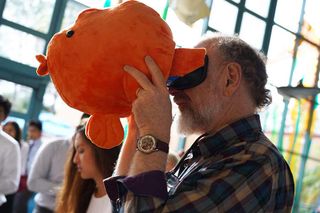Birch Aquarium at Scripps is breaking a barrier this spring. Instead of allowing visitors to just watch local marine life from behind glass, the aquarium is making it possible for visitors to experience life as fish do—thanks to a 360-degree virtual reality exhibit built by UC San Diego undergraduates.
The new exhibit will be Birch Aquarium’s first virtual reality experience and is made possible by campus-wide collaborations led by the Jacobs School of Engineering and its multidisciplinary Summer EnVision Experience program.
[High Tech Storytelling: Museums, Exhibits, and AV]
Visitors to the aquarium will don a mask shaped like one of La Jolla’s local marine animals—a bright orange Garibaldi fish, or a spotted Leopard Shark, for example. The mask is equipped with a VR headset, allowing visitors to tag along on a dive into kelp forests off of Channel Islands National Park. Future forays are planned into the San Diego-Scripps Coastal Marine Conservation Area, located just steps from the aquarium. This will allow aquarium visitors to experience life in one of California’s verdant Marine Protected Areas (MPAs).
“I am particularly excited for this because it breaks a barrier that we haven’t been able to break prior, which is to introduce VR into our aquarium as a legitimate way to connect people to Scripps science,” said Harry Helling, executive director of Birch Aquarium at Scripps. “And so we were excited to learn that the students took this on as a challenge, and to see that they’ve succeeded is a big deal for our aquarium, whose primary role is to translate complex science for general audiences.”

Ten undergraduate students spent 10 weeks over the summer crafting a way to incorporate virtual reality into the aquarium for the Summer EnVision Experience (SEE) program at the EnVision Arts and Engineering Maker Studio. The program, now in its third year of partnership with Birch Aquarium, is building on the Jacobs School of Engineering’s commitment to collaboration. SEE brought together students from different disciplines across campus—engineering, cognitive science, interdisciplinary computing, and the arts, for example—to collaborate with each other and the environmental researchers at Scripps Institution of Oceanography. Together, they were challenged to create an exhibit that would provide aquarium visitors with a deeper understanding of the need for Marine Protected Areas.
“It was really interesting to learn how to use the EnVision studio maker space because I had very limited experience using it before,” said Will Stock, an interdisciplinary computing and the arts student. “It was really nice to be able to get a lot of experience using laser cutters, 3D printers, and sewing machines.”
[How AV is Moving Museums Forward with Immersive Technology]
This is the third year of the Summer EnVision Experience internship program, thanks to philanthropic support from the Charles Lee Powell Foundation, which provided funding for the program.
“I’m predicting that this is going to be very popular and that this is the start of an exciting journey for all of us here at the aquarium and also for future SEE classes,” Helling concluded.











